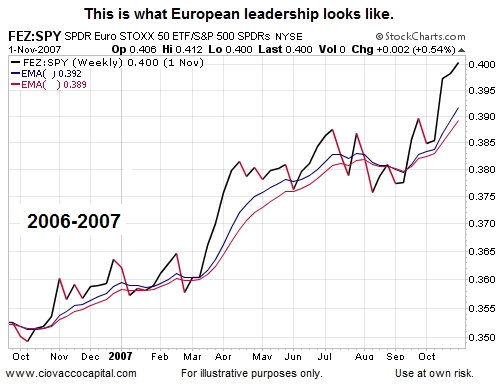ECB To Step Up As Fed Steps Back?

The euro fell broadly on Wednesday, hitting a 19-month low against the Swiss franc, as speculation that the European Central Bank (ECB) will resort to quantitative easing was fueled by yet more bad news from the euro zone…ECB chief Mario Draghi fueled speculation that monetary policy would be further loosened in the euro zone over the weekend by saying the central bank would use “all the available instruments” to deal with the threat of deflation at the U.S. Federal Reserve’s annual conference in Jackson Hole. Developments on Wednesday only worsened the picture for the euro zone: data showed German consumer morale fell for the first time in 1-1/2 years, while Italy’s economy minister said the country must cut its growth forecast.
Time To Jump On European Equities?
Investors in the United States have seen QE’s impact on asset prices. With the ECB/quantitative-easing story beginning to gain more traction, European stocks (FEZ) have beaten the S&P 500 by over 2.0% this week (see upper right corner of chart below). However, European stocks have some work to do to reverse what has been a bearish trend relative to the S&P 500 in 2014.
This Is The Look We Want
If the 2014 chart above could morph into a look similar to the period shown below, our interest in European stocks would increase. For our time frame and approach to the markets, some patience remains in order to see the impact of any chess move by the ECB.
Investment Implications – The Weight Of The Evidence
If you are new to the concept of using observable evidence to manage risk, Anatomy Of A Stock Market Turn illustrates the approach by examining the S&P 500 between August 7 and August 26, 2014. Before we went to press, the S&P 500 was still drifting around 2,000, but with the weekly gain still above 10 points. Until the evidence changes in a meaningful way, we will continue to hold U.S. stocks (SPY), and leading sectors, such as healthcare (XLV), complemented by a small stake in bonds (TLT).
Question image from Marco Bellucci via Flickr creative commons (image has been altered slightly).


